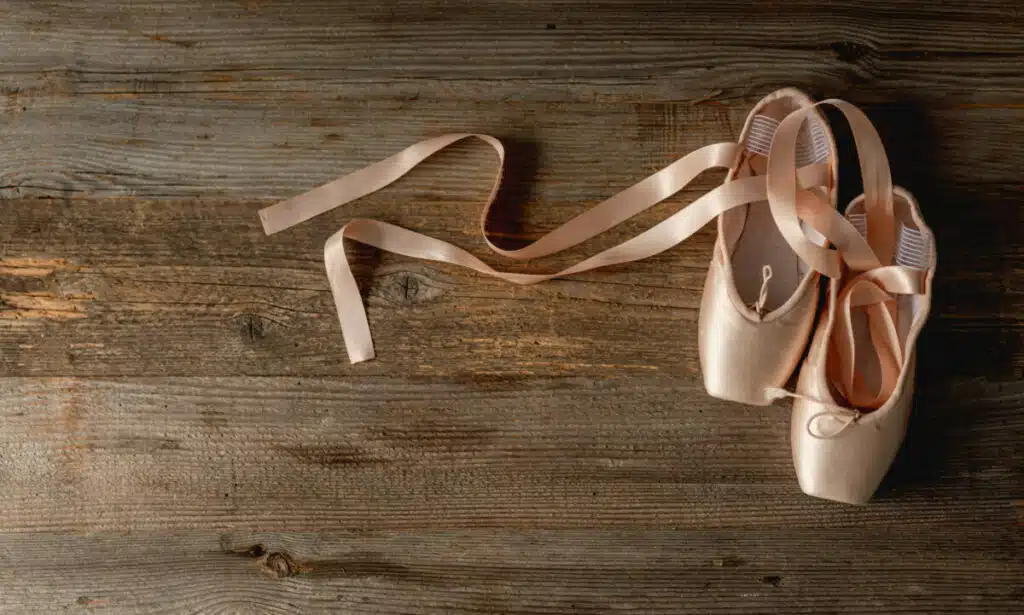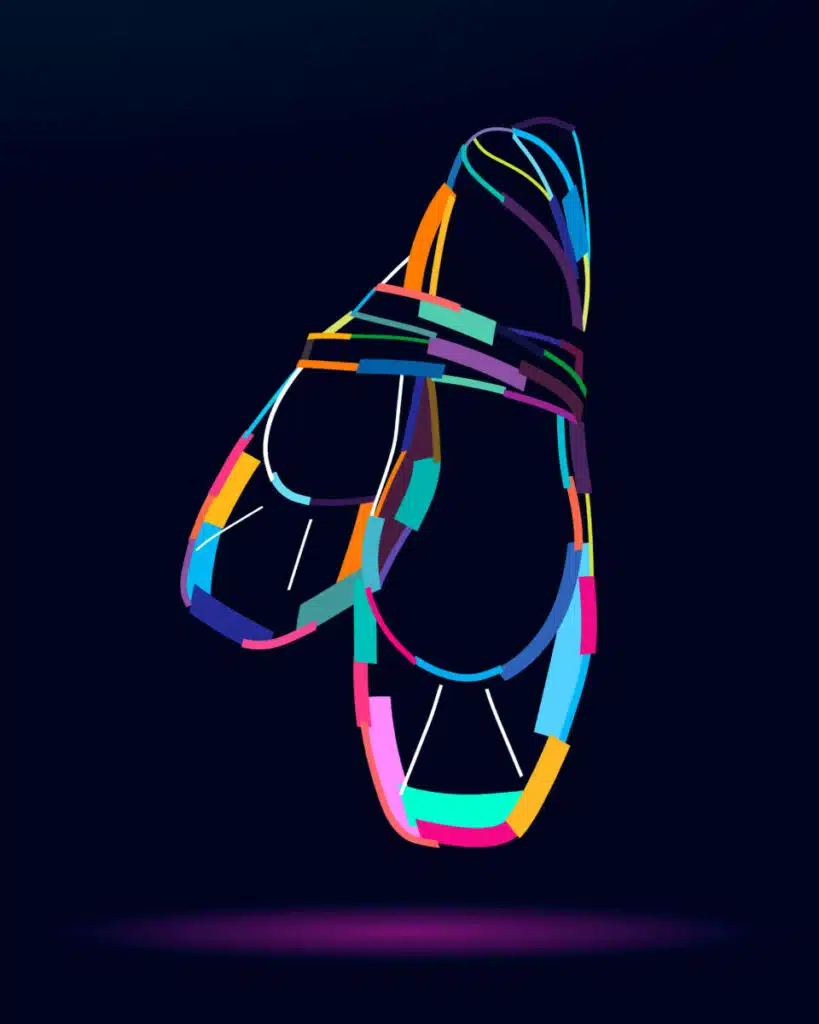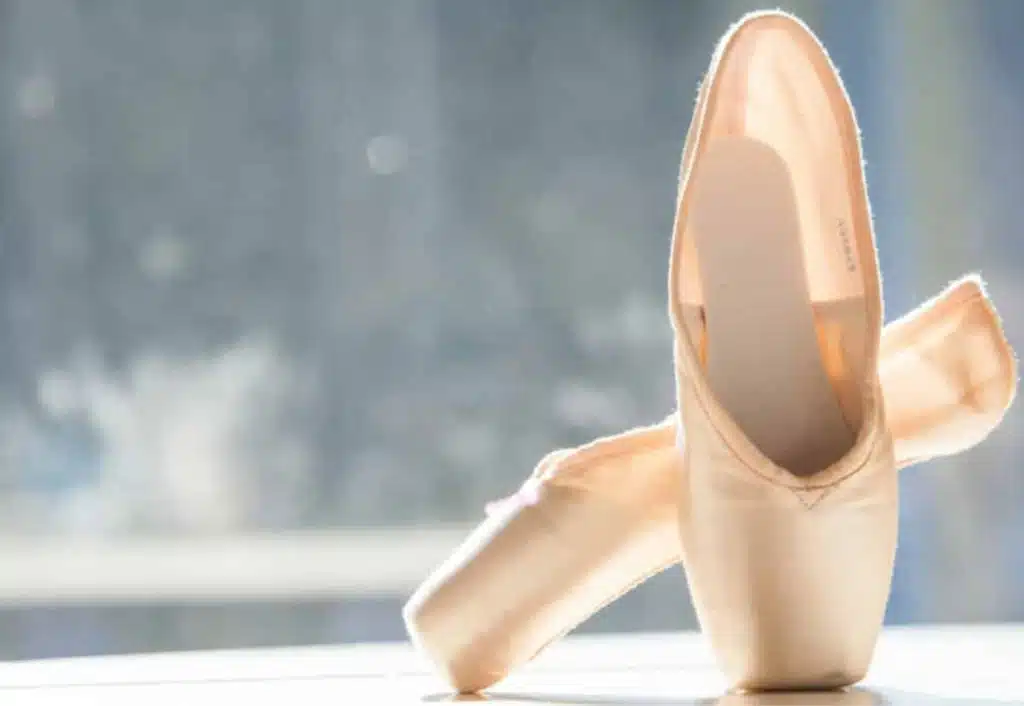Getting well-fitted pointe shoes is key to comfort while what may be hours and hours of pointe work. But pointe shoes are symmetrical whereas your feet are not. Toe pads can be the difference between extreme discomfort and little discomfort at all.
The best toe pads for pointe shoes are Perfectfit Point Inserts because they are as light and unobtrusive as possible while providing the level of comfort one needs to practice. Certain feet shapes and conditions such as bunions will necessitate the use of different types of toe pads.
This article will provide some suggestions for what may constitute the best of the different types of toe pads out there. It will also attempt to answer some of the most common questions regarding toe pads and other forms of foot comfort measures used when wearing pointe shoes.
Best Overall Toe Pad For Point Shoes: PerfectFit Pointe Inserts
Uses
Fills in the negative space in your shoe box while allowing you near full control of your pointe shoes.
Materials
Made of moldable putty.
Pros
Extremely customizable, moldable, comfortable, and durable.
Cons
Extremely expensive compared to most gel and cotton alternatives.
Intended Audience
Professional dancers who want to invest in their long-term comfort when doing pointe work.
Best Budget Toe Pads: Grishko 1010B Perforated silicone pads
Uses
Grishko 1010Bs are great for everyday comfort and practice.
Materials
Silicone.
Pros
Perforated to allow the foot to “breathe”; makes shoes stink less and increases comfort.
Cons
Can be somewhat constrictive if you have wide feet.
Intended Audience
Beginners and experts alike.
Best Toe Pads for Narrow Feet: Ouch pouch style toe pads – TH 004
Uses
Ouch pouch style toe pads (these are not made by the Ouch Pouch company) are perfect for protecting toes and joints during pointe work.
Materials
Gel and fabric.
Pros
Very durable and comfortable.
Cons
Don’t fit well if you have wide metatarsals. Relatively bulky due to the double layer of materials.
Intended Audience
Beginners and intermediate dancers.
Best Toe Pads for Wide Feet: Pillows for Pointes Gel Tip Toe Pillows
Uses
These Gel Tip Toe Pillows are great for toe protection and comfort for those with wide feet.
Materials
Non-silicone polymer tip with polyester material.
Pros
Excellent for those with wide feet, and extremely soft and comfortable.
Cons
Not good for those with narrow or long feet
Intended Audience
Beginners/intermediate dancers.
Best Silicone Toe pads: Eurotard Pointe Comfort Fashion Lites Gel Toe Pads
Uses
Eurotard Pointe Comfort Fashion Lites Gel Toe Pads are excellent for everyday foot comfort and protection when using pointe shoes.
Materials
Gel
Pros
Lightweight, great breathability, bunion protection, and durability.
Cons
Gel toe pads are generally bulkier than some other options, and may not fit well on wide feet.
Intended Audience
Beginners
Best Gel Toe Pads: Pillows for Pointes Gellows
Uses
Pillow for Pointes Gellows are a classic choice and are great for making pointe work much more comfortable.
Materials
Gel and cool max cotton.
Pros
Reversible (one side is a gel and the other a cool max cotton sock), relatively thin, multiple sizes.
Cons
Somewhat expensive.
Intended Audience
Beginner/intermediate dancers.
Most Durable Toe Pads: Prestige Gel Toe Pads – TH 001
Uses
Prestige gel toe pads are convenient and comfortable for everyday pointe work.
Materials
Pros
Lots of different colors and scents are available, durable, and very cushiony.
Cons
Somewhat bulky, and are just as thick on the back as on the front, which may make the toe box cramped.
Intended Audience
Beginners
Best Traditional Toe pads: Gaynor Minden Dynamic Box Liner
Uses
Gaynor Minden Dynamic Box Liners are wonderful for providing the minimum level of comfort needed to do pointe work.
Materials
Faux leather
Pros
Very unobtrusive, allow for more control of pointe shoes, and fill in space on top of metatarsals.
Cons
Not very comfortable compared to many of the gel alternatives.
Intended Audience
Intermediate and pro dancers.
Most Comfortable Toe Pads: Capezio Ouch Pouch Junior
Uses
Capezio Ouch Pouch Juniors provide supreme comfort for everyday pointe work comfort and joint protection.
Materials
Gel and polyester.
Pros
Extremely comfortable, very popular with dancers of all experience levels, and very supportive.
Cons
Somewhat expensive, and may not fit wide feet very well.
Intended Audience
Beginner and intermediate dancers.

What are the different types of toe pads?
Foam toe pads
Foam toe pads are great because they are inexpensive, and great for beginners due to their versatility. However, they do flatten over time, and they can be relatively bulky. The bulkiest foam toe pads can prevent you from moving your toes at all by reducing the space in the toe box, which in turn reduces your control over your pointe shoes. Many people still swear by them though, as they are quite breathable compared to some of the newer gel toe pads, and still provide a lot of comfort.
Gel toe pad
Gel toe pads are typically going to be more expensive, but more comfortable and durable than foam toe pads. They absorb shocks very well, tend to be kind of bouncy, which many dancers like, and they effectively reduce blistering, bruising, and friction in the toe box. Their biggest advantage over foam toe pads is that they provide more protection while being less bulky.
Covered gel toe pads
Covered gel toe pads are just gel toe pads with a fabric covering. The fabric covering adds a little bit more durability to the pad itself, extending the lifetime of said pads. They can also help reduce friction even further by adding two additional layers between your feet and your pointe shoes at once.
Neoprene
Neoprene toe pads are a bit of a middle ground between foam and silicone toe pads, providing a little less comfortable experience than foam pads but taking up less space.
Box Liner
Box liners are a great choice for professionals. They don’t wrap around the whole fit, and instead, just go on top of the metatarsals. They are light, inexpensive, and can be trimmed to fit any size pointe shoe, and they provide the bare minimum amount of comfort to not be too bulky.
Lamb’s wool
Lamb’s wool is one of the most traditional and widely used materials for toe pads. It is useful due to its high moldability, meaning that it can be shaped to fit any size foot and pointe shoe easily. Lamb’s wool is light, breathable, and inexpensive. The only drawback of using lamb’s wool is its lack of convenience compared to just slipping on a premade toe pad, and its lack of comfort compared to some of the thicker gel toe pads.
Spacers
Toe spacers are an option for those who need them to help reduce the effects of bunions, and to prevent the toes from rubbing together. They are typically used interchangeably with toe pads and in conjunction with taping the feet.
Cotton
Cotton toe pads are very similar to foam toe pads, except that they are a lot thinner. This means that cotton toe pads will be less bulky but less comfortable as well than similar foam toe pads.
Do you need toe pads for pointe shoes?
Some schools do not allow any at all, however, this can be very painful, especially if your pointe shoes do not fit your feet very well. However, toe pads can be bulky and reduce control, which makes it harder to have good form. Even very small and thin toe pads can be helpful while mitigating the drawbacks typical of using toe pads.
Toe pads are largely necessary because they help reduce friction and prevent bunions from forming by reducing ligament and skeletal damage. One way they do this is by filling in empty spaces in a pointe shoe, which decreases the room for injury, as well as deformation of the foot over time. This is necessary because your pointe shoes are symmetrical while your feet are not, which places extra pressure on certain parts of the foot while leaving gaps between the pointe shoe and the foot in other places.
Overall, the less bulky the toe pads you choose are, and the lighter they are, the better. Pointe shoes look better with less bulky toe pads, and toe pads do, as mentioned earlier, slightly reduce the control you have while doing pointe work by moving your feet higher away from the ground. What it really comes down to is comfort and safety. If your feet are so uncomfortable without toe pads that practicing becomes painful and injurious, then you are probably better off getting toe pads than going without them.
How to choose pointe shoe toe pads
The number one guideline when choosing pointe shoe toe pads is as follows: choose the lightest pad that provides as much comfort as you need. This will help to both prevent discomfort and injury while also preventing your pointe shoes from looking and feeling too bulky, as well as keeping the level of control you have over your feet as high as possible.
Wear the same pads while fitting the pointe shoes that you will use while dancing because even light padding can change the fit of a pointe shoe’s box and width. In other words, you should purchase a toe pad at the same time as you choose your point shoes, which will ensure that they are both a good fit for each other as well as your feet. A good pointe shoe fitter will be able to help you choose a combination of point shoes and padding/box liners/spacers that will be appropriate for the shape and size of your feet. Trying on a few different toe pads will help you get a good idea of what feels best.
Finally, choosing the right toe pad requires a bit of experimentation. What feels best during fitting might feel slightly better or worse once it comes down to actual classes/practice. Luckily, there are a lot of different options to choose from, so chances are you’ll be able to find a toe pad that works well with your foot shape and pointe shoe.
What happens if you have bunions?
If you have bunions, you might consider getting spacers. Toe spacers will not correct nor prevent bunions in and of themselves, but they can make the condition much more tolerable during practice and performance. Of course, make sure to only wear spacers as needed, because they can reduce the amount of control one has while doing pointe work. Toe spacers that are too bulky can lead to extra discomfort by making the outside toes rub against the inside of the shoe, which is of course the opposite of what they are supposed to do. Taping can also help relieve bunions.
Be careful about getting a shoe that is too wide to accommodate your bunion. Certain exercises, such as toe push-ups, can help strengthen the muscles of the feet to help prevent future bunions. Ensuring that the vamp is long enough will prevent you from curling your toes and increase the chances that you could get a metatarsal stress fracture, the chances of which are increased if a dancer has an advanced bunion.
Don’t switch shoes as they break in, this can cause compression on the bunion. In addition, doing so will wear out your pointe shoes unnecessarily fast, an unintended and potentially expensive side effect. The more you switch out your pointe shoes, the longer it will take for them to be broken in, and the more painful it will be for your feet.
Point shoes should be regularly evaluated to make sure they are not aggravating the bunion and replaced when they no longer offer the support they are supposed to. Street shoes should also be chosen for good support. After all, if you spend most of your day wearing street shoes, they will have a big effect on your foot health over time. Certain orthotics can help to prevent the aggravation of bunions, and these orthotics, while unpractical for use in pointe shoes, are very convenient to use in street shoes during downtime.
In terms of specific toe pads, consider trying the Xtra Long Gellows by Pillows for Pointes, which are designed specifically with bunions in mind.
What are good brands?
Capezio, PerfectFit, Grishko, and Pillows for Pointes are all excellent and well-recognized brands for pointe shoe pads. Of all these, Grishko is the most popular. Grishko offers a few different kinds of toe pads made up of varying materials. Capezio is a really big name right now because of the great gel toe pads that they offer, which seem to be well-liked by both dancers and fitters. All in all, the best brand is going to fit your foot and pointe shoe the best.

Related Questions
How to use lambswool as a toe pad?
The first step in using lambswool as a toe pad is to cut a piece of lambswool into two pieces: these pieces should be just big enough to fill in the gaps in your pointe shoe. Secondly, you will want to pull the wool apart a little and wrap it around the front of your bare foot. Whatever material is left should be over the top of your toes, Your toes should be covered entirely, just as they would be if you were using a pre-shaped toe pad. Next, cover the homemade pad with tights and put on your pointe shoes. Make adjustments as necessary, but do note that the wool will compress to the shape of your foot as you do pointe work. Finally, just make sure to replace the lambswool as necessary once it no longer is supportive enough.
Should you tape your toes in pointe shoes?
Taping your toes can be beneficial for several reasons. Taping your feet can:
- Reduce friction/blisters
- Relieve pain caused by bunions or existing blisters, and help prevent additional joint pain and wear
- Straighten toes, improving pointe form
Ultimately, whether or not you should tape your toes is something that can be determined in conjunction with your dance instructor and with the aid of a pointe shoe fitter, but for some people, it is worth trying to alleviate foot pain while doing pointe work.
How to tape toes in pointe shoes?
Taping toes in pointe shoes is relatively simple, and the process will vary depending on the shape of one’s foot. The basic idea is to tape around the toes which will typically experience the greatest amount of friction with the foot. Think of the big and small toes and the ones next to them. Of course, you can tape each toe individually, but you will want to apply more or less tape depending on which areas tend to develop hot spots the fastest or tend to get blisters. Tape wrapped around the toes can be anchored to the rest of the foot with a couple of pieces of tape laid flat on the top of the foot, overlapping with the other tape.
Some people find that they don’t need pointe shoe pads if they tape their feet a certain way, while others like to use both in conjunction. Some people use pointe shoe pads but not tape. It is easy to combine tape with a simple and unobtrusive box liner cut out to match the shape of your foot, as demonstrated in the video below.
How to clean toe pads for pointe shoes?
Cleaning toe pads for pointe shoes is very simple. Once every month, just wash them thoroughly with water and antibacterial soap and then let them air dry fully before putting them back in your pointe shoes. Of course, since they are subject to such a constant amount of wear and tear, pointe shoe toe pads should be replaced about once a year or whenever they have been compressed so badly that they are no longer useful. Things like toe spacers can also be cleaned similarly (and should be!).
Can you use homemade toe pads for pointe shoes?
Beginners will have the easiest time sticking to ready-made toe pads, but lambswool is one type of toe pad that can be made readily at home. Additionally, toe pads can be improvised from any number of different household items, including toilet paper and paper towels. Yet another good option for homemade toe pads is to create them using socks, with 1 or 2 socks for each foot, modified to fit into the pointe shoe.
Further Reading
If you enjoyed this article, then you will likely find value in our related article Best Pointe Shoes: Backed by a 20-year ballet dancer, a perfect accompaniment for your new toe pad knowledge.

